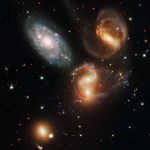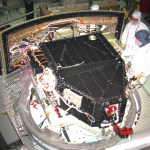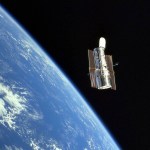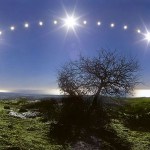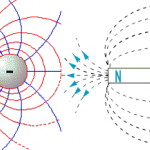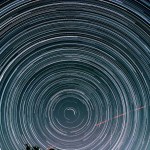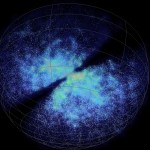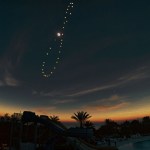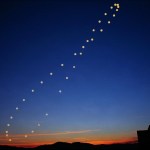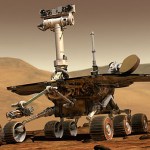
Last week, we got a chance to talk about why the sky is red toward sunset and sunrise but blue everywhere else: the atmosphere. Red light passes through the atmosphere pretty well, but blue light gets scattered more easily. When you look to the horizon at sunset/sunrise, the light passes through a tremendous amount of atmosphere, scattering the blue light all over the sky, but allowing the red light through to your eyes.
But then, I got a very good follow-up question:
Sometimes, either at night or in the morning, not just the horizon but nearly the entire sky turns red! Why does this happen…
Like to go to the movies? Like movie theatre popcorn/candy/slushies/etc.? And do you also like surreal humor?
Take a listen and look at Mastodon's "Cut you up with a Linoleum Knife". It isn't the normal music I listen to, but it's one of my favorite movie openings ever.
But this totally amuses me this weekend, and I hope it gets you, too! (And bonus points if you know what movie it comes from.)
Perhaps my favorite of the new Hubble pictures is this one of Stephan's Quintet (and click here for the 1000 pixel wide version):
It's so stunning that it was chosen as today's Astronomy Picture of the Day. But yesterday, I got a very interesting question to go along with it:
These galaxies are far away, and so we're looking at them in the past. What do they look like today, and are there still five of them?
This is a great question. First off, looking at the image, some of you will count only four galaxies. That's because there are two galaxies that are in the process of merging. You can…
Yesterday, I linked to the Hubble Site, where they've got a collection of stunning new images taken using Hubble's new camera, the Wide-Field Camera 3:
But why would you bother to go there? After all, you know that I'll just show you all the gorgeousness here! Hubble is an astounding telescope, because it's so good for viewing things that are both incredibly close and incredibly far. So here are the highlights!
First off, Hubble can take incredible pictures of our Solar System. Remember that Jupiter recently got hit by an asteroid? Take a look at the big black debris spot by the South Pole,…
Remember saying goodbye to Hubble's old camera, WFPC2? This servicing mission was months ago, now, so perhaps you've forgotten about this 19 year old telescope.
Well, the new camera, WFC3, is finally ready to make its debut. Plans include surveying the Kuiper Belt, looking at newly forming planets, better measuring dark energy, and a new, improved Ultra Deep Field of the distant Universe.
But, as always, the images are what do it for me. Take Stephan's Quintet, a group of five galaxies close together. Regular telescope? Go, and click to enlarge:
Not bad. But one of the first pictures that…
Sure, we're all familiar with sunsets, and how they appear to turn the entire sky close to the horizon red at night.
But it turns out it isn't just the Sun, and it isn't just the sky. If you look at the Moon at either Moonrise or Moonset, guess what color it appears to be? (Even in urban settings!)
Too difficult to tell? Let's find you a better picture done with time-lapse photography.
What's going on to cause this? Why do things which aren't normally red appear red when you look at them on the horizon, from the Sun to the Moon to the sky itself?
This is all the atmosphere's fault. After…
One nice new feature we've got here on scienceblogs is the Editor's Picks feature, found on the front page. While browsing it this weekend, I was drawn to this provocative article. In it, Benjamin Cohen writes of his interview with Rebecca Solnit, who says the following when asked about nuclear power as a viable solution to our energy concerns:
Well, the first problem is that they still think like big science--that there is "the answer." In fact, there are hundreds of little answers that don't include nuclear, including scaling back our consumption and travel and building better and using a…
It's something we take for granted in our modern, civilized world, but a really severe winter brings a lot of challenges with it. Dar Williams, in her song February, sings a beautiful piece about living through the worst of it:
Some places have it far worse than others. For instance, in many places of the world relatively close to the equator, the dead of winter still brings tremendous amounts of daylight:
In other places closer to the Arctic/Antarctic circles, the winter solstice barely brings any daylight at all, making for an incredibly dreary, depressing time:
But some people thrive in…
Electric charges come in two types, positive and negative. Magnetic poles also come in two types, North and South. In both cases, like charges/poles repel, and opposites attract. The big difference? Electric charges can exist in isolation; you can have just a positive or negative charge by itself. Whereas in a magnet, you always need both a North pole and a South pole; you can't have a magnetic monopole.
Magnetic monopoles have always been a curiosity for physicists, and many of us think that they ought to exist. In the 1970s, there were searches going on for them, and the most famous one…
One of the things I always wondered was why Galileo's Eppur si muove! (And yet, it moves!) was such a big deal. Yes, he was talking about heliocentricity, and the Earth moving around the Sun instead of the other way around.
But I was a little bit puzzled. Why, after all, would the Earth moving be such a revolutionary idea? Every night, if you look up and watch the skies over time, you'll see something like this:
The sky rotates! Not only do the stars in the night sky rotate, but the Sun's path through the sky also goes along one of the same paths that the stars do, as does the Moon. (For a…
So, I have a small confession for you, my readers. Since I first started writing this blog, I have always solicited questions, and promised to answer the best ones. Recently, this has come back to bite me, as I've started getting more questions than I possibly have time to answer. However, the ones that meet the following criteria:
are of interest to a very broad, general audience,
are clear, well-posed, and straightforward, and
I can actually provide an answer to them,
will, more often than not, get answered right here. This one comes from reader Dan Noyes, who writes:
I have a question…
Okay, as many of you had heard, I've got a new job as a full-time Professor. And not only am I pretty excited about it, I thought I'd share with you one of the more interesting things I taught on the first day.
I got this idea from talking to Michael, the chair of the department (and this is not the first time he's taught me something neat). Chances are, if you're in a classroom, that one thing everyone has is a piece of paper.
If you folded this piece of paper in half, it would now be twice as thick as it was before:
So my question is this: how many times would you have…
Ain't no sunshine when she's gone.
It's not warm when she's away.
Ain't no sunshine when she's gone
And she's always gone too long anytime she goes away.
Bill Withers' song Ain't No Sunshine has been covered by over 100 major artists since its release in 1971, but I think the original is still the best (sorry, DMX).
Those of you who've been following this blog since the old site know that I don't write very often about my personal life. But there's a big life change that's happening for me right now that's related to the Astronomy/Cosmology/Physics.
You see, back in the spring of 2006, I…
Yesterday, I showed you a picture of 100,000 nearby galaxies, which made me feel small, even when we just look at our (relatively) local Universe. Today, let's go down to the other end of the spectrum.
Electron microscopes have been around for a long time, and they've let us see some very advanced structures at amazingly high resolutions. For example, here are some individual pollen grains:
But what if you want to go deeper? What if you wanted, say, to see an individual protein and how it's folded? Well, we have the technology (such as at the Advanced Photon Source) to image and infer the…
Ever wonder what it would look like if you took about 100,000 nearby large (i.e., Milky Way sized and larger) galaxies, reduced each one to a point, and mapped them? Well, at Swinburne University of Technology in Australia, they did this, from the point of view of where we are in the Universe. We are the Milky Way, the one dot dead center in this image. Take a look, and click to enlarge:
Does it make you feel insignificant? Or does it make you feel like you're a part of something wondrous? Or both? However it makes you feel, I hope you enjoy looking at it!
On Monday, I posed a question to you as to why, when you photograph the Sun at the same exact time every day for a year, you get something that's shaped like a figure 8, like so:
Image credit: Tunc and Cenk Tezel.
We got a good number of thoughtful comments, many of which are on the right track, and many of which have some misconceptions. Let's clear them up, and then let's give you the explanation of what gives us our figure 8, and why other planets make other shapes.
What does the analemma look like at other places on Earth? You can see, above, that (from the ruins) the above analemma is…
There's a new book out there, Why Does E=MC2 (and Why Should We Care?), by Brian Cox and Jeff Forshaw. One of Seed's editors, Elizabeth Cline, took a read through it and wrote about her experiences and what she learned. Is relativity, particle physics, and all the related science really incomprehensible to all except the scientists working on it? Cox and Forshaw don't think so, and neither do I. So I wrote an article for SEED Magazine here. Here's an excerpt:
Inside of every atom -- every proton, every neutron, every electron, even every neutrino in the Universe -- lies the secret of…
I'm trying something new here: I'm going to give you a little bit of information and a teaser, and we'll see -- in the comments section -- whether any of you can figure it out.
Imagine that you went outside, each and every day at the same time, and mapped the position of the Sun. What would you see?
Image credit: Astrosurf.
Doing this -- taking a snapshot of the Sun at the same exact time from the same exact place on different days -- gives you what's called an analemma. Now, on Earth, the top of the analemma happens during the Summer Solstice, the lowest point of the analemma happens…
Once a week, all the top astronomy/space writers from around the net get together -- thanks to Fraser Cain at Universe Today -- and contribute their top stories to the Carnival of Space. This week, Mike Simonsen of Simostronomy hosts, and brings together some great stories in this week's Carnival of Space. Go and check it out; here are my top three picks:
1. Robots galore! Ever wonder what your favorite missions to other planets are up to? From as close to the Moon to the outer edge of the Solar System, the Planetary Society has mission updates from Mercury to Saturn to Pluto.
2. An eclipse…
New technology has led to breakthroughs in practically every aspect of our lives since the dawn of the industrial revolution. In nearly every case, it's for the betterment, in some way, of society. (And yet, I like my music best when it's acoustic, unprocessed, and barely produced at all.) Take a listen to Song for Roy by the amazing Sam Bush (with help from Emmylou Harris) about his late bass player, Roy Huskey, Jr.
One of the more memorable technological advances in my lifetime came in the mid-1990s, when DNA testing/evidence became a very controversial part of our culture with a…

